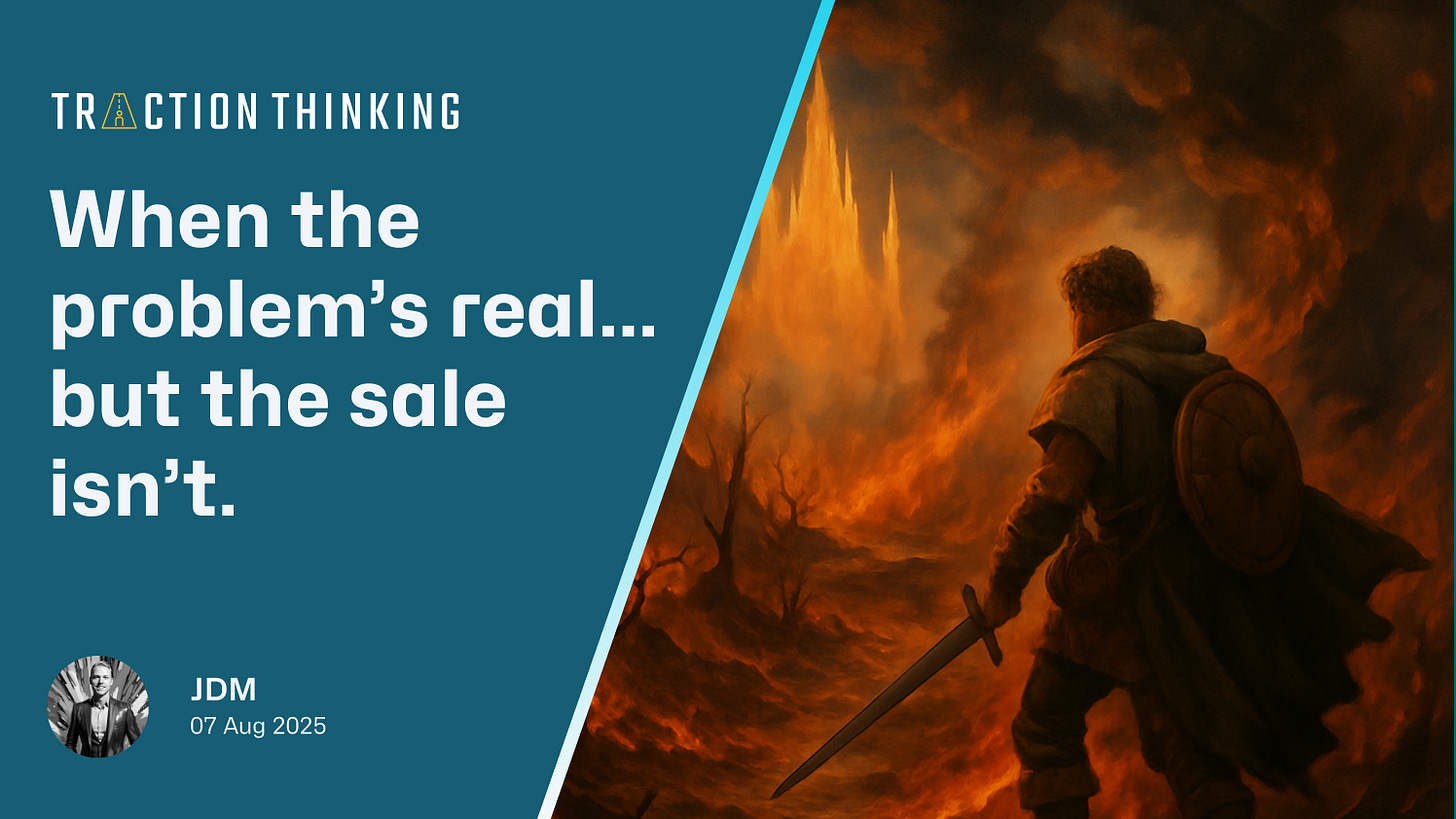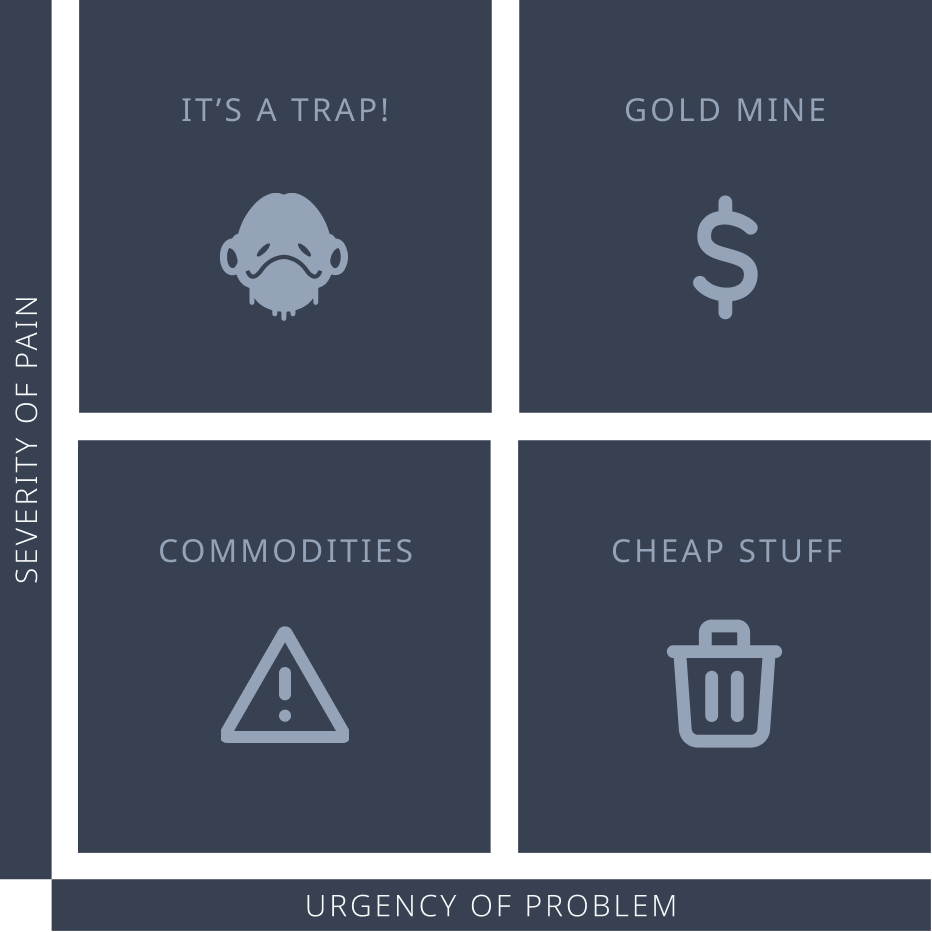When the problem’s real… but the sale isn’t
They told you the problem was real. They said they’d use the solution. They even smiled during your demo. But when it came time to buy? Crickets. Here’s why it was never gonna happen.
Hey friends 👋
It starts with a great interview.
The customer says the problem is real. You can see it in their eyes. They say your solution is smart. They’d love to use it.
All signs point to “yes”! You’re singing inside.
And then?
Nothing.
No signup. No pilot. No deal. Just a trail of ghosted emails and slowly fading confidence.
But here’s the worst part: you actually built something that solves a real problem.
So what went wrong?
It just wasn’t a problem anyone’s in any rush to solve.
This is the most common death spiral I see in early-stage startups: the slow startup suicide.
Not a flameout. A slow, quiet bleed — chasing a problem that’s severe but not urgent.
It’s time to talk about how to spot it — before it wastes 12 months you’ll never get back.
Let’s dive deep 👇
Let’s jump straight to the punchline:
Severity and urgency are not the same thing.
Just because a problem hurts doesn’t mean anyone’s going to do anything about it. Especially not today. Especially not by paying you.
Even if it hurts a lot.
That’s where founders get stuck: they chase severe problems — real pain, real stakes — and assume urgency follows.
But urgency doesn’t follow. It leads.
You can solve the gnarliest, most frustrating problem in someone’s workflow — and still get ignored — because it’s not problem #1, #2, or #3 on their list.
It’s problem #5. And nobody pays to solve problem #5.
So let’s map this out.
We’re working with two variables:
Severity — How painful is the problem?
Urgency — How quickly do they need it solved?
Put those on a 2x2 and you get four quadrants:
Let’s break them down:
Low severity / low urgency: Commodities nobody cares. Not even you. Move on.
High urgency / low severity: Cheap commodities. These are the “we need it now” problems that don’t hurt that bad. Think: toilet paper. Great for volume. Terrible for margin.
High severity / high urgency: The gold mine. This is where you want to be. Painful problem. Time-sensitive. Budget unlocked.
High severity / low urgency: The mirage. Looks real. Feels real. Gets applause. But nobody buys. Because it’s not a priority — at least not yet.
And if you’re building in that last quadrant?
You’re headed for a long, slow burn with nothing on the other side.
Here’s how it plays out:
The Traction Mirage: hospice care for startups
Customers told you the problem was real, and that they’d use your solution.
They said, “Wow, that would be amazing.”
And then… nothing.
No conversion. No urgency. Just dust.
This is the mirage quadrant in action: a problem that’s real, painful, and completely ignorable.
Here’s why it’s so dangerous:
It looks like validation. Customers nod. They commiserate. Their eyes light up in the interview. It looks real. That’s the trap.
It feels like momentum. You get “interest.” You get compliments. Maybe even a few LOIs. But none of it converts.
It becomes your roadmap. You start building for people who say they want it. But “want” is cheap. You needed urgency — and didn’t realize you didn’t have it.
In short? It burns your time, your runway, and your team’s belief.
You don’t just lose months — you lose confidence, focus, and morale. Founders second-guess everything. Investors lose interest. It spirals.
And the worst part?
You made a plausible bet. You followed “evidence.” You did “customer discovery.” You built something real.
But you made a critical, unchecked assumption:
“If the problem’s bad enough, they’ll definitely act.”
It seems reasonable, but in reality, we all suffer through major pains every day that we don’t dedicate any time, energy, or money into solving — until something forces us to act.
Until there’s a triggering event.
Urgency doesn’t describe pain — it confesses priority. And if it’s not a priority, even the best solution dies waiting.
⚠️ Found yourself in the traction mirage? Let’s fix that before you burn another quarter chasing compliments. Talk to a venture scientist.
Here’s how to spot the mirage before it wrecks your runway:
Testing for urgency
So how do you avoid chasing a mirage?
You test for urgency.
Not vibes. Not validation theatre. Actual urgency.
The kind that shows up in decision-making, not just in demos.
Here are four tactics:
First, stop leading the witness.
You know what’s not helpful?
Asking, “Would a tool that does X be useful to you?”
They’ll say yes. Because why not?
It sounds free.
It sounds helpful.
It makes them feel helpful.
And you’ll walk away thinking: Validation unlocked.
Except it’s not. It’s performance.
If you want real signal, you have to stop planting ideas in their head.
Instead, ask them about their actual priorities.
Instead of “Is this a problem for you?”, ask:
“What are the top three things you’re actively trying to solve right now?”
“What’s slowing your team down the most?”
“Where’s the bottleneck that’s getting attention this quarter?”
“If I gave you a magic wand to fix one thing tomorrow, what would you pick?”
Urgency reveals itself in priority. And priority reveals itself in constraints.
No one has time for everything. So figure out what they’re making time for.
Use the 100-point test.
If they’ve already listed a bunch of problems, try this:
“If you had a $100 budget to solve these 5 problems, how would you allocate it?”
They’ll divvy it up. Some will get $40. Some will get $5. Some will get $0.
That’s a revealed preference. That’s where you focus.
Above all, watch what they do — not what they say.
Urgency isn’t just verbal. It’s also behavioral.
Where are they spending budget?
What roles are they hiring for?
What’s getting airtime in all-hands meetings?
What tools are they duct-taping today just to get by?
If they say a problem is huge but haven’t touched it in six months? That’s not urgency. That’s inertia.
Urgency leaves footprints. You just have to stop squinting at compliments and start tracking movement.
Let’s talk about how to map what you find.
Plotting the problem
Once you’ve gathered the data, don’t just sit on it. Map it.
Grab a whiteboard (or Figjam).
Draw the quadrant: severity on the X axis, urgency on the Y.
Just like the above. Emoji optional.
Now write down every problem your customer mentioned. One per sticky note.
Then, one by one, hold the sticky at the very center of the map, and ask yourself:
More painful, or less painful?
More urgent, or less urgent?
And then stick it to the board.
The top right is where you focus. That’s where traction lives.
Everything else is noise.
TL;DR?
Don’t just build for what hurts. Build for what can’t wait.
And if you’d like to chat with a venture scientist about how to uncover those pains four your startup, book a call with the Traction Lab.
Until next week,
—jdm





